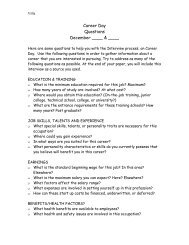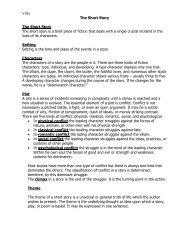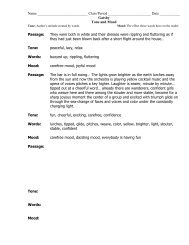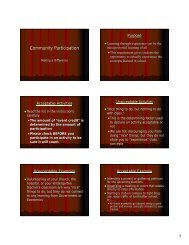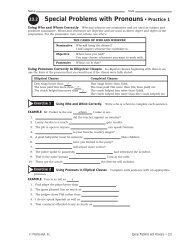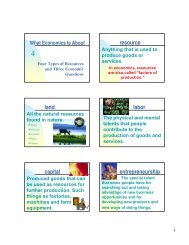Personality 1
Personality 1
Personality 1
Create successful ePaper yourself
Turn your PDF publications into a flip-book with our unique Google optimized e-Paper software.
4/21/2008<br />
<strong>Personality</strong><br />
Psychodynamic<br />
Approaches<br />
Common Components<br />
• Psychodynamic theories emphasize<br />
personality as a dynamic process<br />
representing the conflict of various<br />
multidirectional sources of psychic energy<br />
that motivate an individual to behave in a<br />
particular way.<br />
Conflict<br />
Biology and Adaptation<br />
• Because an individual cannot satisfy all<br />
these multidirectional sources of psychic<br />
energy at one time, conflict naturally<br />
ensues.<br />
• Biological drives (particularly sexual ones)<br />
play a major role in the psychodynamic<br />
theories as one source of conflict that<br />
individuals must resolve in adapting to their<br />
environment.<br />
• Because adaptive demands change as we<br />
age, psychodynamic theories place<br />
considerable emphasis on the influence of<br />
early childhood experiences on our<br />
resulting adulthood personality.<br />
The Unconscious<br />
• Determinism, or the idea that we have little<br />
control over the forces that rule our<br />
behavior, is another feature of<br />
psychodynamic theories.<br />
• The neo-Freudians, or theorists that<br />
followed in Freud's wake, de-emphasized<br />
determinism, choosing instead to<br />
emphasize more control over one's actions.<br />
• The influence of unconscious forces on<br />
behavior is also stressed in some form or<br />
fashion by psychodynamic theories.<br />
• Keep in mind that t Freud and other<br />
psychodynamic theorists were clinicians, as<br />
are many psychodynamic theorists today.<br />
1
4/21/2008<br />
• Consequently, their data is obtained from<br />
clinical observations of patients seeking<br />
treatment, a selective sample under<br />
uncontrolled conditions, which will have<br />
implications when evaluating this approach.<br />
Sigmund Freud:<br />
Psychoanalysis<br />
• The structure of personality<br />
• Defense mechanisms<br />
• The stages of development.<br />
The Structure Of <strong>Personality</strong><br />
• For Freud, the mind had two basic levels:<br />
unconscious thought and conscious<br />
thought.<br />
• Freud usually added d a pre-conscious level l<br />
too, which acted as a kind of storage buffer<br />
for items currently out of awareness that<br />
could easily be brought into conscious<br />
thought.<br />
• Freud also divided the mind into three<br />
structures operating within these levels of<br />
consciousness: the id, the ego, and the<br />
super ego.<br />
• The id and super ego are largely<br />
unconscious, while the ego was mostly<br />
consciousness.<br />
The Id<br />
• the id is the unconscious personality<br />
structure which represents the instinctive,<br />
and irrational source of primitive impulses.<br />
• It functions via a primary-process thought. ht<br />
• That form of thought is irrational, driven by<br />
instincts, and not in touch with reality.<br />
The Id<br />
• Infants are capable only of primary-process<br />
thought.<br />
• Adults mainly experience it in dreams or in<br />
slips of the tongue because adult conscious<br />
thought will not accept it.<br />
2
4/21/2008<br />
The Id<br />
• For example, Freud believed that dreaming<br />
represented two forms of content: manifest<br />
content and latent content.<br />
• Manifest content t consists of the actual<br />
dream imagery, and latent content is the<br />
symbolic interpretation of manifest content.<br />
The Id<br />
• Latent content’s function is to protect the<br />
person from primary-process thought<br />
because of its unacceptability to the<br />
conscious mind.<br />
• Sometimes, multiple latent content items<br />
can be represented together in an image.<br />
Freud termed the dreaming of such images<br />
condensation.<br />
The Id<br />
• Freudian theory states that dreams also<br />
function in wish fulfillment.<br />
• Thus, the id's impulses that are<br />
unacceptable in reality could be released<br />
safely in dreams.<br />
• The id is governed by the pleasure<br />
principle, or the notion of pursuing<br />
immediate gratification, regardless of<br />
external realities.<br />
The Ego<br />
• The second structure of the personality, the<br />
ego, is the surface of the personality, the<br />
part you show the world.<br />
• The ego is governed by the reality principle,<br />
i in which it responds to the world as it is,<br />
and not as a person may want or believe it<br />
should be.<br />
The Ego<br />
• The ego uses secondary-process thought,<br />
which is rational and grounded in reality.<br />
• The ego, then is the mind’s interface with<br />
the world and it mediates between the id’s<br />
desires and the world's constraints,<br />
constantly seeking acceptable<br />
compromises for both.<br />
The Superego<br />
• The third structure of Freud's personality<br />
structure is a superego. The superego<br />
represents the personal unconscious<br />
representation of society's s values and<br />
norms.<br />
• It develops later than the ego, primarily<br />
through interaction with others, especially<br />
parents are caretakers.<br />
3
4/21/2008<br />
The Superego<br />
• As such, much of the superego consists of<br />
a personal replica of parental superegos.<br />
• The idealistic principle governs the<br />
superego. That principle i mostly reflects<br />
personal conceptions of morality, not<br />
reality. Consequently, the superego, as<br />
well as the id, is irrational.<br />
The Superego<br />
• The superego is subdivided into two parts:<br />
the conscience and the ego-ideal.<br />
• The conscience develops from the<br />
experience with punishments and rewards,<br />
and thus it is represented by the familiar<br />
metaphor of an angel and the devil on each<br />
shoulder. The conscience decides what<br />
course of action one should take.<br />
The Superego<br />
• The eco-ideal is an idealized view of one's<br />
self and, therefore, reflects societal and<br />
moral ideal behavior (e.g., "good children<br />
do not hit their siblings")<br />
).<br />
• Comparisons are made between the egoideal<br />
and one's actual behavior. Both parts<br />
of the superego develop with experience<br />
with others, or via social interactions.<br />
Defense Mechanisms<br />
• Because the demands of the id and the<br />
superego are often diametrically opposed,<br />
the ego needs some form of protection<br />
from these urges. Freud proposed the idea<br />
of defense mechanisms to address this<br />
issue. Defense mechanisms are<br />
unconscious methods used to protect the<br />
ego from the simultaneous pleasure urges<br />
of the id and the moral demands of the<br />
superego.<br />
Defense Mechanisms<br />
• The main defense mechanisms are denial,<br />
repression, projection, displacement,<br />
sublimation, reaction formation,<br />
rationalization, and regression.<br />
Denial<br />
• A reality that causes anxiety is simply not<br />
perceived. One fails to acknowledge<br />
possible negative consequences of their<br />
behavior.<br />
• For example, partying the night before final<br />
exams would be denial, or driving under the<br />
influence of alcohol is denying the effects of<br />
alcohol on the body and mind.<br />
4
4/21/2008<br />
Denial<br />
• Similarly, a mother may unconsciously<br />
refuse to see your son's true character<br />
because it is too anxiety-arousing.<br />
• The use of denial may lead to abrupt<br />
intrusion of reality into one's life.<br />
• The mother, for example, may receive the<br />
news that her son has been arrested for<br />
armed robbery.<br />
Repression<br />
• Repression is when highly anxiety-arousing<br />
items are involuntarily stored deep in the<br />
unconscious, where they will not affect<br />
conscious activities.<br />
• Repressed items, however, may<br />
symbolically manifest themselves in<br />
dreams or in slips of the tongue.<br />
Repression<br />
• A repressed item is not readily available for<br />
recall. Instead it may spontaneously<br />
appear later, unexpectedly, yet supposedly<br />
when the individual may be better prepared<br />
to deal with the anxiety of the event.<br />
• For example, a young woman started to<br />
experience extreme panic when her<br />
daughter turned three years old. She was<br />
extremely vigilant and protective of her<br />
daughter.<br />
Repression<br />
• When examining this change in her<br />
behavior under therapy, she recalled<br />
having been sexually molested herself<br />
when she was three years of age and this<br />
event has been repressed for over two<br />
decades.<br />
Projection<br />
• Projection is attributing one's thoughts,<br />
desires, or feelings to someone or<br />
something else.<br />
• One partner may say to another, "you want<br />
to date other people," when in reality these<br />
are the desires of that person.<br />
Displacement<br />
• Displacement is a redirection of energy<br />
from the source that caused it to a safer<br />
substitute.<br />
• A professional athlete t may throw his glove<br />
on the field when in reality he is angry at<br />
his coach or the umpire.<br />
• Similarly, a young child may punch a wall<br />
or throw her toys after being reprimanded<br />
by a parent.<br />
5
4/21/2008<br />
Sublimation<br />
• Sublimation also redirects energy to a more<br />
socially acceptable one as in displacement,<br />
but this redirection is usually more<br />
productive than is seen in displacement.<br />
• For example, attraction to a married person<br />
may be redirected into exercising after<br />
seeing this person. Aggressive instincts<br />
may also be sublimated, as when after a<br />
huge argument, you may clean your house<br />
or car.<br />
Reaction Formation<br />
• Reaction formation is showing the exact<br />
opposite of one's true motivation or<br />
intentions.<br />
• Saying "I hate you" may indicate love<br />
instead. Or believing that you love to teach<br />
may be necessary after you've spent years<br />
preparing and then found out that the only<br />
job you could obtain was in a horrible<br />
school with violent students.<br />
Rationalization<br />
• The choice is to admit you wasted your<br />
time and energy preparing for such a job or<br />
to believe that you enjoy it.<br />
• Rationalization is realizing that one's<br />
motives are not always pure or publicly<br />
acceptable and substituting appropriate<br />
explanations for these motives.<br />
• For example, failing to study because one<br />
was "exhausted" rather than "lazy" is an<br />
example. Being lazy is not seen as a<br />
socially acceptable motivation.<br />
Regression<br />
• Similarly, an alcoholic may claim the<br />
drinking helps "calm me down" or "allows<br />
me to be more sociable."<br />
• Regression occurs when the coping<br />
behaviors of an earlier developmental<br />
stage reappear.<br />
• For example, crying or throwing a tantrum t<br />
may be used to cope with a stressful event.<br />
• Typically, we view such behaviors as<br />
inappropriate for adults and further, as<br />
holdovers from an earlier time (childhood)<br />
when such behaviors were more<br />
acceptable.<br />
6
4/21/2008<br />
Regression<br />
• Consequently, it is not uncommon for an<br />
older sibling to start wetting the bed or<br />
sucking his or her thumb when a baby is<br />
added to the family.<br />
Stages Of <strong>Personality</strong><br />
Development<br />
• For Freud, personality characteristics result<br />
from the manner in which we resolve all<br />
four stages of psychosexual conflict.<br />
• The first stage, the oral stage, runs from<br />
birth to age 2. In the oral stage infants and<br />
toddlers derive pleasure primarily through<br />
their most sensitive area, the mouth. They<br />
also learn to use their mouth to<br />
communicate.<br />
Stages Of <strong>Personality</strong><br />
Development<br />
• The next stage is the anal stage. In the<br />
anal stage, from two to four years of age,<br />
children derive pleasure from the<br />
elimination of bodily wastes.<br />
Stages Of <strong>Personality</strong><br />
Development<br />
• The phallic stage (four to six years of age)<br />
is probably the most controversial. In this<br />
stage, children discover their sexual<br />
differences as they derive pleasure from<br />
self-stimulation.<br />
Stages Of <strong>Personality</strong><br />
Development<br />
• Per Freud, this stage can give rise to<br />
Oedipus (for males) and Electra (for<br />
females) conflicts, in which young children<br />
have unconscious incestuous desires for<br />
the opposite-sex parent (boys fall in love<br />
with their mothers and girls fall in love with<br />
their fathers), and fear or hate the same<br />
sex parent.<br />
Stages Of <strong>Personality</strong><br />
Development<br />
• To reduce the anxiety of the ego in dealing<br />
with these id desires and super ego<br />
demands (one should love parents, not<br />
hate them), the ego engages in several<br />
defense mechanisms.<br />
7
4/21/2008<br />
Stages Of <strong>Personality</strong><br />
Development<br />
• These feelings for the opposite-sex parent<br />
are sublimated into more appropriate<br />
activities; the child engages in reaction<br />
formation and identifies or becomes more<br />
like the same sex parent in order to reduce<br />
the fear and anger toward this parent; and<br />
the defense mechanism of repression<br />
accounts for why no one can remember the<br />
events of the stage.<br />
Stages Of <strong>Personality</strong><br />
Development<br />
• Those complexes lead, according to<br />
Freudian theory, to normal differentiation of<br />
male and female personalities.<br />
• The phallic stage is followed by a latency<br />
period in which little new development is<br />
observable. In this stage, boys typically<br />
play with boys, and girls with girls. Sexual<br />
interest is low or nonexistent.<br />
Stages Of <strong>Personality</strong><br />
Development<br />
• The final stage, the genital stage, starts<br />
around 12 years of age and ends with the<br />
climax of puberty.<br />
• Repressed sexual interest t from the phallic<br />
stage is reawakened at this time and are<br />
transferred into an appropriate oppositesex<br />
age-mate (rather than the parent).<br />
Stages Of <strong>Personality</strong><br />
Development<br />
• To Freud, not all individuals adequately<br />
resolve the psychosexual conflicts,<br />
receiving either too little or too much<br />
stimulation in a particular stage.<br />
• This inadequate resolution is reflected in<br />
fixations or a preoccupation in adulthood<br />
with the demands of these stages.<br />
Evaluating Freud's Theory<br />
• Freud's theory has been criticized for<br />
relying on qualitative case studies of his<br />
own patients (many of them women,<br />
referred to him because of hysterical<br />
symptoms).<br />
• Many feel he placed too much emphasis on<br />
sex and aggression.<br />
The Neo-Freudians<br />
• Freud's influence was such that he inspired<br />
others (much like Piaget) to learn about his<br />
theory.<br />
• The term Neo-Freudians (new Freudians)<br />
often is used to describe those<br />
psychoanalysts who proposed changes to<br />
Freud's original theory in some way, both<br />
before and after Freud's death.<br />
8
4/21/2008<br />
The Neo-Freudians<br />
• All of the neo-Freudians accepted much of<br />
Freud's ideas, however; they simply made<br />
modifications in one emphasis or another,<br />
creating their own theories within the<br />
psychodynamic approach.<br />
Alfred Adler: Individual<br />
Psychology<br />
• Adler was the first of Freud's adherents to<br />
break with Freud and propose own<br />
psychodynamic theory.<br />
• He was an early student t of Freud, but then<br />
began to disagree with many of his views.<br />
• He disagreed with Freud over the nature of<br />
forces within a person, arguing that they<br />
were consistent with one another rather<br />
than competing, as Freud proposed.<br />
Alfred Adler: Individual<br />
Psychology<br />
• To Adler, they were consistent in their drive<br />
toward superiority, which gives meaning to<br />
our lives.<br />
• Adler emphasized the terms of superiority<br />
it<br />
and inferiority and named complexes after<br />
both.<br />
• He actually was introducing social factors<br />
into psychodynamic theory by arguing that<br />
social interactions lead to such feelings.<br />
Alfred Adler: Individual<br />
Psychology<br />
• His thinking also was focused on the future,<br />
on expectations. Freud, instead, focused<br />
on a person's past.<br />
• Adler's future orientation ti led him to<br />
conceptualize a strong role for future<br />
fictions or our perceptions of reality (which<br />
may or may not be accurate).<br />
Alfred Adler: Individual<br />
Psychology<br />
• Notice it is not only how one is treated, but<br />
how one thinks they will be treated and how<br />
one interprets how they are treated that<br />
influences one's drive toward superiority<br />
(subjective perceptions).<br />
Carl Jung: Analytical<br />
Psychology<br />
• Jung developed a more complex version of<br />
psychoanalysis, introducing more terms<br />
and constructs.<br />
• Jung accepted Freud's division i i of the mind<br />
into conscious and unconscious, but he<br />
expanded on the contents of the<br />
unconscious.<br />
9
4/21/2008<br />
Carl Jung: Analytical<br />
Psychology<br />
• For Jung, the unconscious consists of the<br />
personal unconscious and the collective<br />
unconscious.<br />
• The personal unconscious stores each<br />
individual's unique and personal<br />
experiences, which are further organized<br />
into complexes, or emotionally charged<br />
thoughts and memories, which function<br />
independently.<br />
Carl Jung: Analytical<br />
Psychology<br />
• The collective unconscious contains<br />
species-wide memories and accounts for<br />
the commonalities of human experience: a<br />
reservoir of inherited unconscious<br />
memories from one's ancestors.<br />
• Archetypes were found in the collective<br />
unconscious, which account for why people<br />
tend to perceive and act on the<br />
environment in similar ways.<br />
Carl Jung: Analytical<br />
Psychology<br />
• So, whereas complexes in the personal<br />
unconscious are unique and individualized,<br />
archetypes are shared among all of us.<br />
• They account for mythical, legendary,<br />
religious, and cultural commonalities.<br />
Carl Jung: Analytical<br />
Psychology<br />
• Four important archetypes are the persona<br />
(the part of ourselves that we show to the<br />
world), the shadow (the part of ourselves<br />
that we hide from others or ourselves), the<br />
anima (the feminine side of a male's<br />
personality), and the animus (the masculine<br />
side of a female's personality).<br />
Carl Jung: Analytical<br />
Psychology<br />
• Other archetypes also play important roles,<br />
including the great mother, the wise old<br />
man, and the hero.<br />
• These archetypes may facilitate t or<br />
complicate our interpersonal relationships<br />
with each other.<br />
• To Jung, personality is reflected in all these<br />
various parts that the self integrates into a<br />
coherent whole.<br />
Karen Horney:<br />
Psychoanalytic Theory<br />
• Horney, too, broke with Freud's conception<br />
of psychodynamic theory.<br />
• She saw the Freudian version as too male-<br />
oriented and too biological. i l She argued<br />
that personality and gender differences<br />
stem from cultural expectations, not from<br />
biology.<br />
10
4/21/2008<br />
Karen Horney:<br />
Psychoanalytic Theory<br />
• Her theory emphasizes basic anxiety, or<br />
anxiety that is generated by the competitive<br />
nature of the modern world.<br />
• In her view, people develop strategies t to<br />
cope with anxiety in three ways.<br />
Karen Horney:<br />
Psychoanalytic Theory<br />
• Demonstrating affection or submissiveness<br />
moves us toward others as a way of coping<br />
with anxiety; striving for power, prestige or<br />
possession moves us against others in an<br />
effort to reduce anxiety, and withdrawal<br />
simply moves us away from others as a<br />
mechanism for dealing with anxiety.<br />
Object-Relations Theories<br />
• Object-relations theory is a present-day<br />
continuation of Freudian theory. However,<br />
it focuses more on our relationships with<br />
others and how we represent these<br />
relationships.<br />
• In this theory, objects are the mental<br />
representations of important people and<br />
provide the basis for the organization of the<br />
self.<br />
Object-Relations Theories<br />
• Successful relations with these objects<br />
foster emotional stability where as<br />
unsuccessful relations foster mental<br />
disorders.<br />
• Additional differences separate objectrelations<br />
theory from classical<br />
psychodynamic theory.<br />
Object-Relations Theories<br />
• First, object-relations theorists delve further<br />
into the person's past than did Freud,<br />
viewing the attachment to the mother as<br />
more instrumental in understanding<br />
behavior.<br />
• They look for attachment difficulties, for<br />
example, or for particularly harsh marine<br />
environments to explain later maladaptive<br />
behaviors.<br />
Object-Relations Theories<br />
• Consequently, for object-relations theorists,<br />
it is the relationship with the mother (rather<br />
than the father as proposed by Freud)<br />
during the attachment process (rather than<br />
the Oedipal stage) that is critical to<br />
understanding adult personality.<br />
11
4/21/2008<br />
Object-Relations Theories<br />
• Moreover, whereas in Freud's theory<br />
explaining female development was<br />
problematic, just the opposite is true for<br />
object-relations theorists, who must explain<br />
how males separate from the attachment to<br />
the mother to re-identify with the father.<br />
Evaluating The<br />
Psychodynamic Approach<br />
• The approach has been enormously<br />
influential without generating much<br />
experimental support.<br />
• Freud's version is fairly comprehensive, but<br />
some Neo-Freudian versions have been<br />
limited in their scope.<br />
• Finally, the paradigm is fairly simple and<br />
has produced a large number of treatments<br />
and techniques.<br />
Evaluating The<br />
Psychodynamic Approach<br />
• Freud is often criticized because he did not<br />
test his theory scientifically.<br />
• Some theorists believe psychodynamic<br />
theory is too deterministic i ti and fatalistic ti in<br />
its approach to human nature, but it<br />
remains an active avenue of research<br />
today.<br />
12



